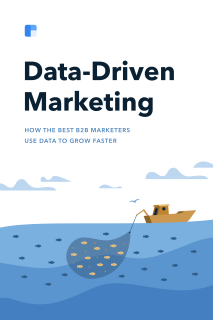Chapter 6
19 minutes
Account Based Marketing

Charlie Liang Head of Marketing at Finch
If you ask five different people what account-based marketing (ABM) means to them, you’ll likely get five different answers. For some, it’s simply an iteration of what they’re already doing in the area of demand generation. For others, it signals a completely new shift in strategy. Or maybe ABM is what they’ve been doing all along. They just haven’t called it that.
As the Director of Marketing at Engagio, I’ve helped hundreds of companies assess how ready they are to do successful ABM—and we all see a lot of advice about that these days. But one of the most overlooked topics is data’s role in the overall strategy, and how it turns an often theoretical exercise into a measurable and justifiable one.
Data is the backbone of an ABM strategy that actually works (with the numbers to prove it). You can’t segment your accounts without it, you can’t prospect without clean contact info, and you can’t understand which outreach works without a solid measurement system.
In this chapter, we’ll learn how three data-driven marketing leaders at B2B SaaS companies rely on data to do account-based marketing right. We’ll see how Kristen Malkovich of Chorus.ai, Mitchell Hanson of Zapproved, and Daniel Day of Snowflake are doing amazing things with data to make ABM more precise and scalable.
Selecting target accounts
Choosing target accounts well is fundamental to the success of an account-based approach, and data helps scale that process and takes out some of the guesswork. The approach is typically different at a startup versus a larger company, and we’ll show you examples of both in a moment.
As a quick review, there are two types of target accounts.
Type #1: Big “whale” accounts. These have a large lifetime value (LTV) and will generate significantly higher revenue than your average customer.
Type #2: Strategic “lighthouse” accounts. These are trendsetters and early adopters in a given vertical. They might not generate significant revenue, but many companies look toward these brands as models, so you’ll be likely to capture more customers as a result of closing them. If you’d put them on the homepage of your website, they’re probably a lighthouse account.
As you choose your targets, start by defining an ideal customer profile (ICP). Target accounts that fit your ICP will be a subset of your Total Addressable Market (TAM). Historically, before the widespread availability of data tools and vendors, sales teams picked an account shortlist by hand, with less (or very little) data to guide their decisions. Today, we have more information at hand, and account selection is a collaborative effort between marketing and sales.
At Engagio, our target account selection committee actually includes representatives from sales, marketing, and the exec team. We count third-party prospect data sources as a valuable fourth committee member. Our selection process typically has three phases spanning two to six weeks.
Phase 1: Marketing uses existing customers’ data and predictive vendors (optional) to establish the ICP and create a shortlist.
Phase 2: Sales selects their target accounts based on Marketing’s shortlist, looking at existing relationships and other criteria.
Phase 3: Executives do a final vet on target accounts and have veto power.
Every company does this differently, though. Let’s take a look at the account selection process for Chorus.ai, a small but growing company that’s just setting up the foundations of their B2B marketing program.
How startup Chorus.ai set up their target accounts
Chorus.ai creates conversation intelligence software for B2B sales teams. Kristen Malkovich, their Director of Marketing, tells us that Chorus.ai’s primary audience consists of sales leaders at large, high-growth tech companies. “We have complex, 90- to 120-day sales cycles for the customers we go after, especially compared to our competitors, who go after a broader market,” says Kristen.
To support their upmarket strategy, they decided to build their marketing program with account-based methods from the start. Since Chorus.ai is a 40-person company with a lean team of four AEs at the time of this writing, it’s particularly interesting to examine their account selection process, as it’s prototypical for smaller startups.
Account selection
Kristen worked with her sales counterparts to look for sales leaders at SaaS companies. They evaluated potential companies in a third-party database based on parameters like:
- Company size
- Sales team: Do they have a minimum of 8 account executives? Is there a sales enablement function? Have there been any significant changes in the sales org recently?
- Existing tools/technology stack, to infer tech savviness and compatibility with Chorus
- Location (US only)
- In a specific set of sub-industries
Next, Chorus broke those accounts into Tiers 1, 2, and 3, with Tier 1 accounts meeting the most stringent, best-fit requirements. Here’s an example of what that might have looked like (this is a fictitious example; confidential Chorus data is not represented).
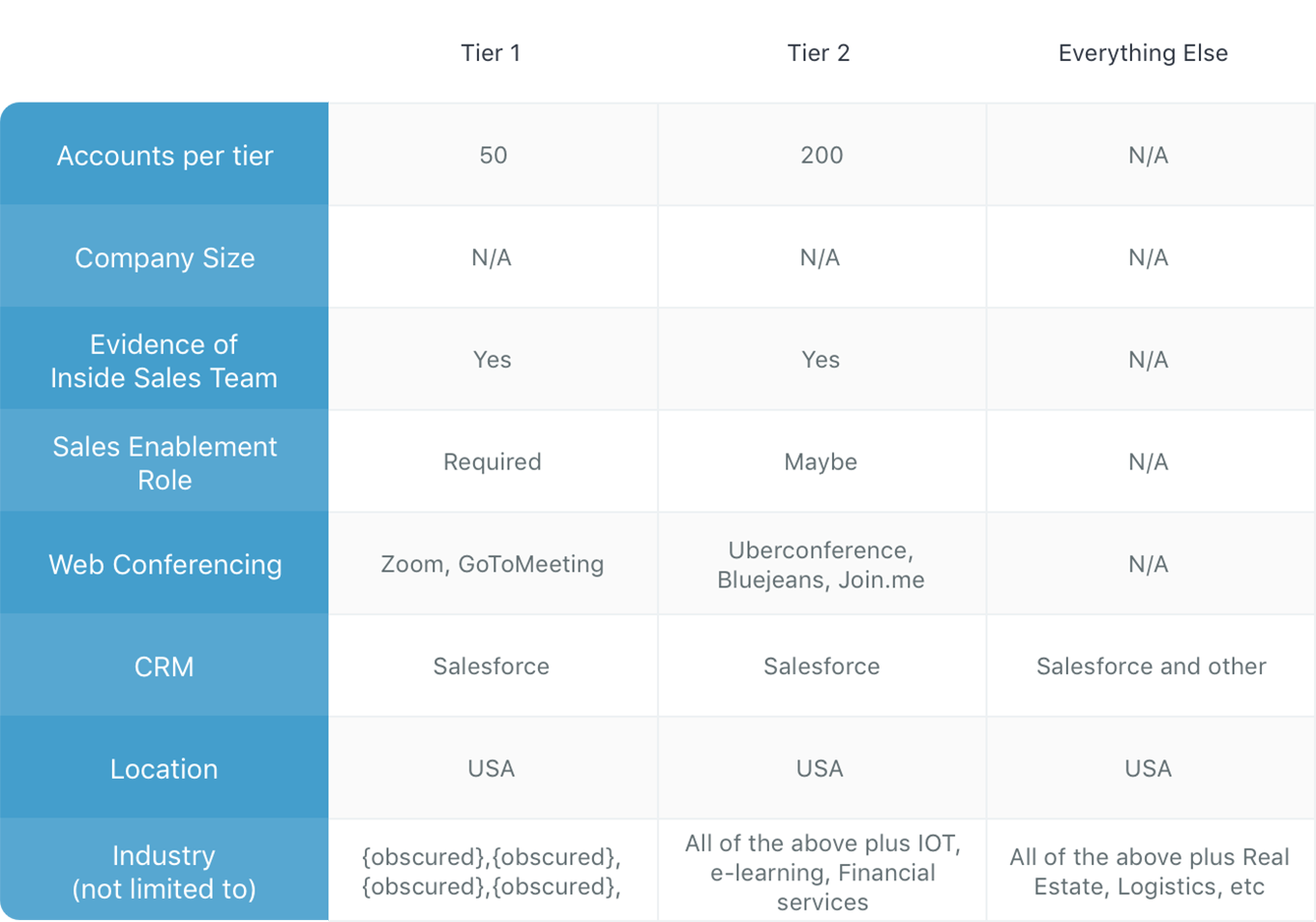
Sample target account tiers
She extracted the accounts into Salesforce. The next step was to find the key people at those specific accounts and their contact information.
Mapping contacts to target accounts and refreshing contact data
Even though it’s called account-based marketing (ABM), at the end of the day, you’re still marketing to people. Having up-to-date information about who works where and how to contact them makes your sales and marketing teams that much more efficient and effective.
To get great contact data for your target accounts, take an inventory of all the relevant decision makers, influencers, and executive sponsors at these companies. Generally, this requires going to a third-party data provider to quickly pull a list of individuals. You can also use manual research via channels like LinkedIn and even phone verification, but because this is very time consuming, save it for only your top accounts and outsource this when it makes sense.
The second step is to keep that potential customer data up to date—an ongoing task. People move into and out of companies all the time, so make sure you keep track of movements such as promotions, key new hires, cross-organization movements, and departures. According to a Biznology survey, changes in people’s titles, contact info, and company names are responsible for a 70% decay rate of B2B records over a 12-month period.
Back to how Chorus.ai did this. After choosing her target accounts, Kristen used a contact provider to acquire the entire set of relevant sales contacts at companies on her shortlist, including sales leadership, sales enablement, and sales operations.
From there, she imported the list into her Salesforce database as leads. She used Engagio’s lead-to-account matching (L2A) to connect those leads (the individuals) to target accounts (their companies) in Salesforce. She could now look at a target company in Salesforce and get a holistic view of all the relevant individuals to market to; their key contact information included business email, phone lines, and social media handles. Or she could view an individual’s record in Salesforce with data about their company, like size, industry, and technology stack.
Then she linked her third-party data provider to Salesforce so that it could refresh data nightly, keeping Chorus’s marketing database clean automatically. “About 96% of our database is consistently clean, refreshed, and ready,” says Kristen.
Quick aside: She also contends with the quick decay rate of B2B data by using SifData to look for people who’ve recently left a company and send them an automated outreach email to keep them in the Chorus universe. It also alerts their CRM.
The benefits of this exercise were immediately apparent to her entire sales and marketing teams. With L2A enabled in Salesforce, lead routing was streamlined and automatically sent companies to the right sales owner. All required background info was already in the system, so sales development reps spent less time doing manual research on their prospects. This freed them up to do more personalized prospecting.
And it’s a big timesaver for marketing. “Marketing ops teams are constantly troubleshooting with sales about why they were routed a lead,” says Kristen. “The biggest benefit I’ve noticed with our data system in place is that these back-and-forth conversations are gone. Marketing and sales teammates all have an account’s info from the beginning.”
Now let’s take a look at the account selection process at another B2B company, where marketing relies on a more structured data model to select accounts for a much larger sales team.
Every account is a Snowflake: Selecting target accounts at a high-growth B2B SaaS company
Snowflake solves hard problems for IT and business intelligence (BI) organizations with its built-for-the-cloud data warehouse, counting Adobe Systems, Nike, Sony, and Capital One as its customers. When Daniel Day joined Snowflake as Senior Manager of ABM, his primary goal was to help align sales efforts with marketing by driving engagement and opportunities with top prospects.
Every quarter, Daniel helps each sales representative identify their top 100 target accounts. For a team of 40 reps, that’s a large undertaking. Snowflake has thousands of target accounts, so Daniel leans heavily on prospect data to scale the account selection process.
Daniel established a set of sophisticated filters that focus on the analytics and IT environments of prospective companies to help identify relevant target accounts based on Snowflake’s ideal customer profile. Clearly defining the target account landscape enables Snowflake to align sales, marketing, and business development on common targeted accounts. These filters include:
- IT budget
- Number of IT employees
- Legacy technology platforms
- Annual revenue growth
- Whether a prospect uses BI tools
He also filters accounts for engagement and coverage—especially important when onboarding new Snowflake account executives. For example, it’s important to note how a particular account has responded to Snowflake’s broader demand generation efforts over the last several months. Coverage here is an important metric—knowing how many contacts are available for a given account. It’s difficult to drive engagement in individual accounts with few or no contacts.
Daniel starts by creating a list of approximately 250 companies for each sales rep that meet his baseline criteria. From there, his sales team whittles the list down to the top 100. Daniel says, “We compile these reports in Excel, ranking them based on criteria for ideal prospects. Then we ask our sales directors and account executives to choose their 100 best-fit accounts, taking into account the reps’ knowledge of the industry and their existing contacts in each account. Then we lock in their list for the quarter, and later we measure ourselves for engagement and coverage against those accounts.”
With this method, Day can scale the selection process and even find commonalities among the accounts. In addition, they’ve hired a marketer to build out vertical- and account-specific content and messaging.
With a solid foundation of data to launch your marketing outreach, it’s time to think about how you’ll measure it.
Measuring the impact of ABM
Marketing is often one of the biggest line items in a company’s cash flow statement, so it’s important to understand the ROI of your account-based programs—especially compared to demand gen, if you have both types of marketing at your company. A good measurement infrastructure also helps you compare ground-level campaigns so you can double down on things that work. We’ll take a look at both of these and learn how it’s done at Zapproved, a niche B2B SaaS that spun up an ABM program out of their existing demand gen team.
To move from measuring traditional inbound demand generation to measuring ABM, one needs to make a few mindset shifts. Demand gen focuses on marketing qualified leads (MQLs): a person-centric metric. ABM introduces a new analytics paradigm that thinks holistically about target accounts, where the key metric is “marketing qualified accounts” (MQAs).
In other words, demand gen analytics asks how many individuals are clicking on marketing campaigns, downloading content, and progressing down the funnel. ABM analytics asks whether the right companies are coming, whether the right companies are clicking.
A good starting point is to take an inventory of your marketing funnel through an account-centric lens, categorizing each one into the following stages.
- All Target Accounts
- No Engagement
- Aware (some engagement)
- Marketing Qualified Account, or MQA (qualified engagement)
- Opportunity (sales opened an opportunity)
- Converted Customer
To illustrate, here’s Engagio’s top-level ABM dashboard, where each “count” is a company, not a lead.
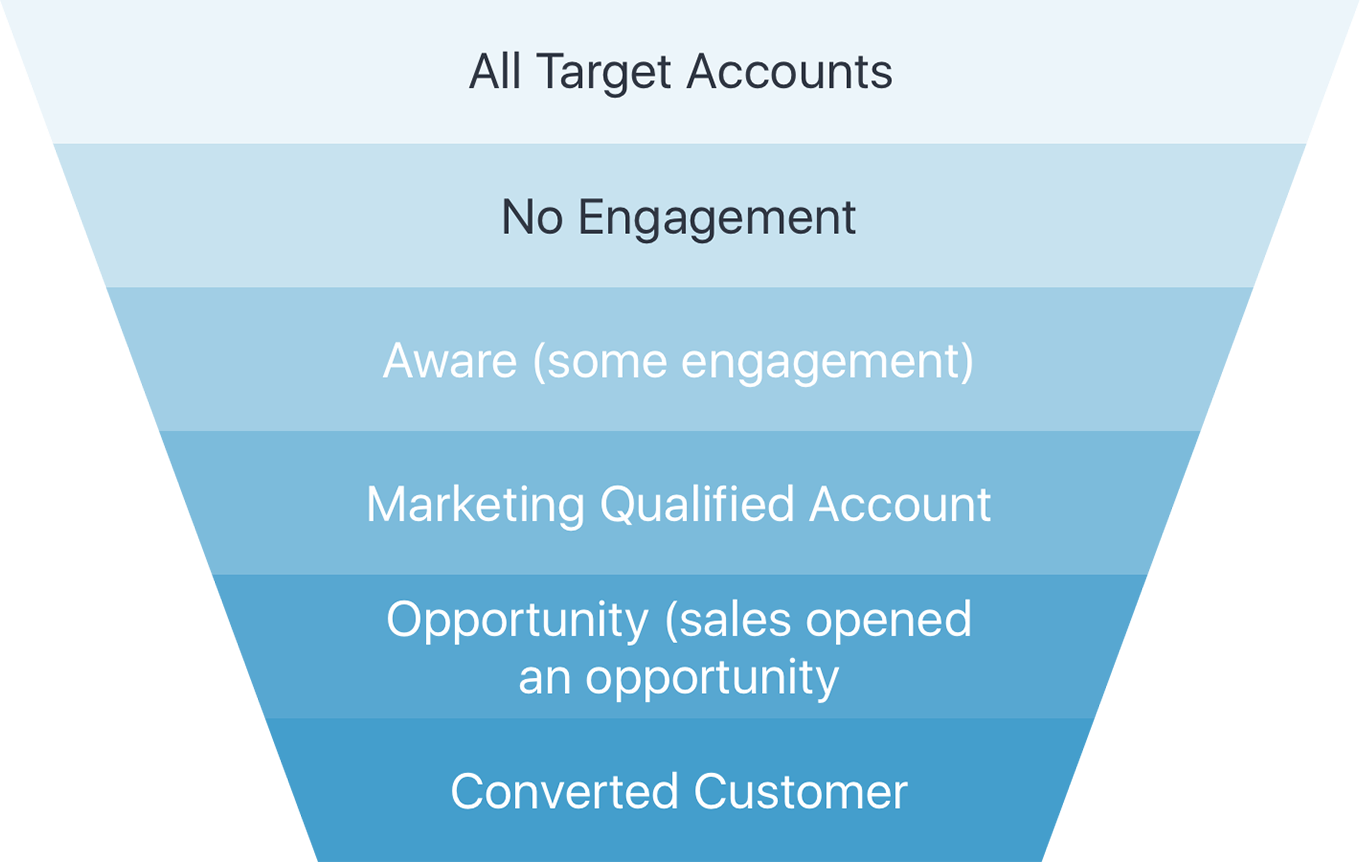
Sample ABM Metrics Dashboard
Every company tracks different funnel metrics to keep a pulse on their marketing program, so let’s meet Zapproved, which is rigorous about its measurement infrastructure.
How an account-based strategy got traction at Zapproved
Zapproved sells cloud-hosted e-discovery software for legal departments, typically targeting Fortune 500 and Global 2000 companies. They’re incredibly niche, and sell to a small, specific team-within-a-team-within-Legal (e-discovery). Mitchell Hanson, Marketing Director at Zapproved, had been investing in traditional lead and demand generation, but as the company grew, it started seeing diminishing returns on more broad-based, top-of-funnel program dollars.
This is quite typical; for many small companies, lead and demand gen is an effective strategy, but as the SaaS moves upmarket, the cost to acquire a customer begins to match or exceed the cost to acquire one with ABM outreach. “We’d bring in tons of leads, but started to lose traction and saw that many were lower-value, or otherwise less than an ideal fit in terms of overall customer acquisition,” says Mitchell. “We needed a complementary approach.”
So he spun up a target account-based marketing program to run alongside lead gen and demand gen with a test budget equal to about 25% of his quarterly demand gen budget.
Mitchell put a rigorous measurement system in place to validate his experiments in comparison to demand gen, and see whether ABM might live up to the promise of bringing in bigger deals and more revenue. He wanted to answer questions like:
- Are deal sizes bigger than with demand-gen-only strategy?
- What percentage of MQAs are progressing to sales opportunities?
- What ABM programs are the best performing?
When introducing a new ABM program to test alongside an existing demand gen program, Mitchell suggests using existing demand gen metrics as a benchmark. “If 10% of demand gen’s leads are progressing, for example, I’m trying to hit or beat that number,” he says.
Mitchell put together a dashboard to keep a pulse on performance. Here are the go-to metrics he includes in a standard report, which takes him about 15 minutes to put together using Salesforce and Engagio data. They give him a sense of how well his accounts are progressing, as well as the return on his marketing dollars.
Selection:
- Number of target accounts per region by tier (for example, 1 = Fortune 50, 2 = Global 2000, and 3 = everyone else)
- Number of total selling hours* needed per region this fiscal quarter
“Selling hours” indicates the expected number of salesperson-hours to be spent on a company or group of companies; usually Tier 1 companies require more hours than Tier 2 companies, and so on.
Coverage:
- Number of in-market contacts for target accounts, by region
Engagement:
- Number of engagement minutes – trailing 7 days by segment
- All Accounts
- Target Accounts
- F1000 Accounts
- Customer Accounts
Zapproved tracks “engagement minutes” through Engagio. This metric aims to reflect how much time the individual leads at your target accounts spend doing meaningful activities with your brand. This typically includes social interaction, reading your brand’s content marketing, and talking to sales
MQAs:
- Number of MQAs created by month
- Number of target account MQAs created by month
Progression:
- % of MQA accounts in trailing 3 months progressing to Meeting or Opportunity status
- progression of all F1000 accounts
- progression of all target accounts
ROI:
- expected ROI for all target account programs by type (early indicator of quality sales pipeline)
- % return on marketing investment (ROMI) for all target account programs, by type (the ultimate metric)
Rigorous measurement demonstrated that Mitchell’s new program was indeed more effective at driving larger deal sizes, and over the next three or so quarters, his test budget grew by 25% each quarter to continue testing and investing in the approach.
In addition to keeping tabs on the ABM program as a whole, it’s important to track which channel- and campaign-level tactics are most effective.
Measuring ABM tactics and campaigns
There’s a popular saying that “account-based marketing is just good marketing.” Account-based outreach consists of a string of marketing efforts carefully curated and targeted to a particular company, and it’s important to measure individual tactics so you can compare them and double down on the best ones. And remember, you’re looking for tactics that work best for target accounts, not overall engagement from everyone.
Mitchell’s ABM program at Zapproved typically involves a mix of 13 tactics, with 8–10 of them being highly targeted or personalized. This includes targeted direct mail, events and trade shows, regional and field marketing events, LinkedIn ads, targeted email, targeted content syndication, and more. With good tracking, Mitchell and his team learned that direct mail has a pretty effective meeting rate, and field events in their industry are great to connect with target accounts.
They also used results metrics to learn which types of demand gen content worked particularly well for their target accounts. While demand gen is all about how many views or downloads you get out of a piece of content, ABM content is about their quality, not their quantity. “Our counterparts in demand gen care about the number of reviews, leads, and shares. I care about how many target accounts were there. If one of them converts, a white paper pays for itself 1,000 times over,” says Mitchell.
Mitchell can look at the visitors to a poorly attended webinar, notice that several target accounts are attending, and ask the demand gen team to double down on that topic. He can also justify investments in niche and hyper-personalized content, which can be really expensive to produce but can help test the viability of a new market segment.
For example, they created an FOIA (Freedom of Information Act) solution brief for local, state, and federal governments. “I can say to demand gen, ‘I know you spent a lot of time on that report. Only 10 people downloaded it, but eight were target accounts, so keep doing those.’ I could say that before, but now that I have the data to back it up, it’s easier,” says Mitchell. In another example, they produced a niche whitepaper about Title IX investigations to test the potential to crack into the education segment. This ended up being one of the best industry solution briefs, which validated the sales team’s suggestion to go deeper into education. It also helped the demand gen team get proof that this type of content works well so they could scale it into a multi-channel effort.
Zapproved used units of “engagement” as one measure of content effectiveness, with minutes as a proxy for how much a target account has engaged with your brand (a metric that Engagio advocates for). It’s more than just a unit change—it’s a fundamental question of whether the right people at the right accounts are spending time with your company.
Daniel Day at Snowflake took this further and used engagement minutes to determine which accounts to double down on with campaign efforts. Daniel says, “We were able to segment our display advertising, direct mail, and one-to-one campaign tactics based on this engagement funnel. This let us progress tactics to ensure we’re meeting our account engagement goals for the quarter. Account engagement is the common measurement that sales, business development, and marketing can all agree on. By targeting in this way, we show complete support to our field team by serving up campaigns that match account progression.”
A/B testing ABM campaigns
Another interesting way to use data in account-based outreach is to A/B test your B2B marketing tactics. This is difficult because ABM campaigns are exercises in small numbers. But I believe that the more experimentation one can bring to an account-based marketing strategy, the better. Here’s how we’re trying it at Engagio.
We generally set up our ABM campaigns against a control group so we can isolate campaign impact and show results. The downside to this approach is that not everyone receives our ABM campaign, but at least we can have a comparison.
We recently ran a campaign where the primary goal was to get an introductory meeting at a target account with little to no previous engagement. The campaign spanned across four weeks involving multiple “players” on both the Engagio side and the prospect side (decision makers, influencers, partners, and executive sponsors). We involved multiple marketing tactics in this campaign, but it centered around a direct mail package that was sent to the decision maker with “goodies” for them and the other players as well. The package included:
- A copy of our Clear and Complete Guide to ABM, either in printed book form or on a Kindle
- Five pairs of Engagio socks
- A handwritten, personal postcard
- An umbrella (if it was raining in the area)
Here is a high-level look at the overall play we used. To set the stage, you can see that we first ran ads to increase awareness of Engagio (for our experimental group). Then, to officially kick off the play, we sent the package with the goodies.
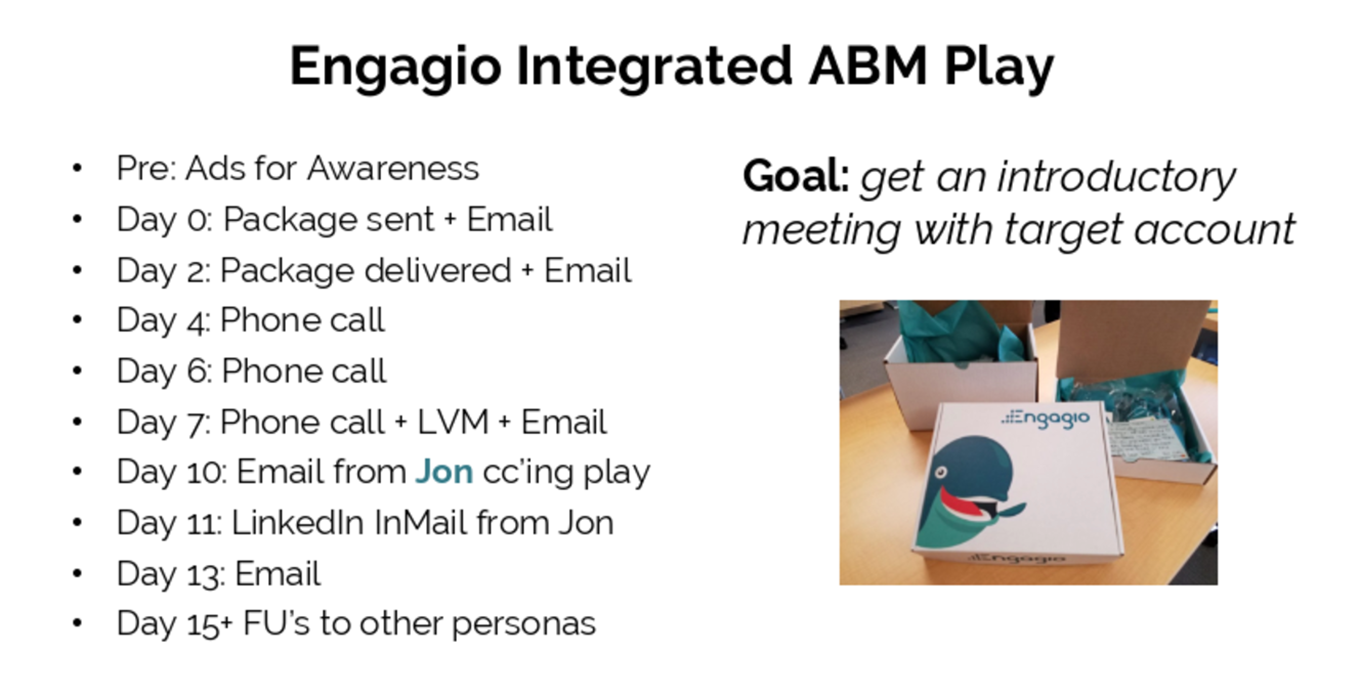
See the results below. By data science standards, they weren’t statistically significant. But with the small numbers we work with in the ABM world, they were directionally meaningful to us and we’ll continue to try testing.
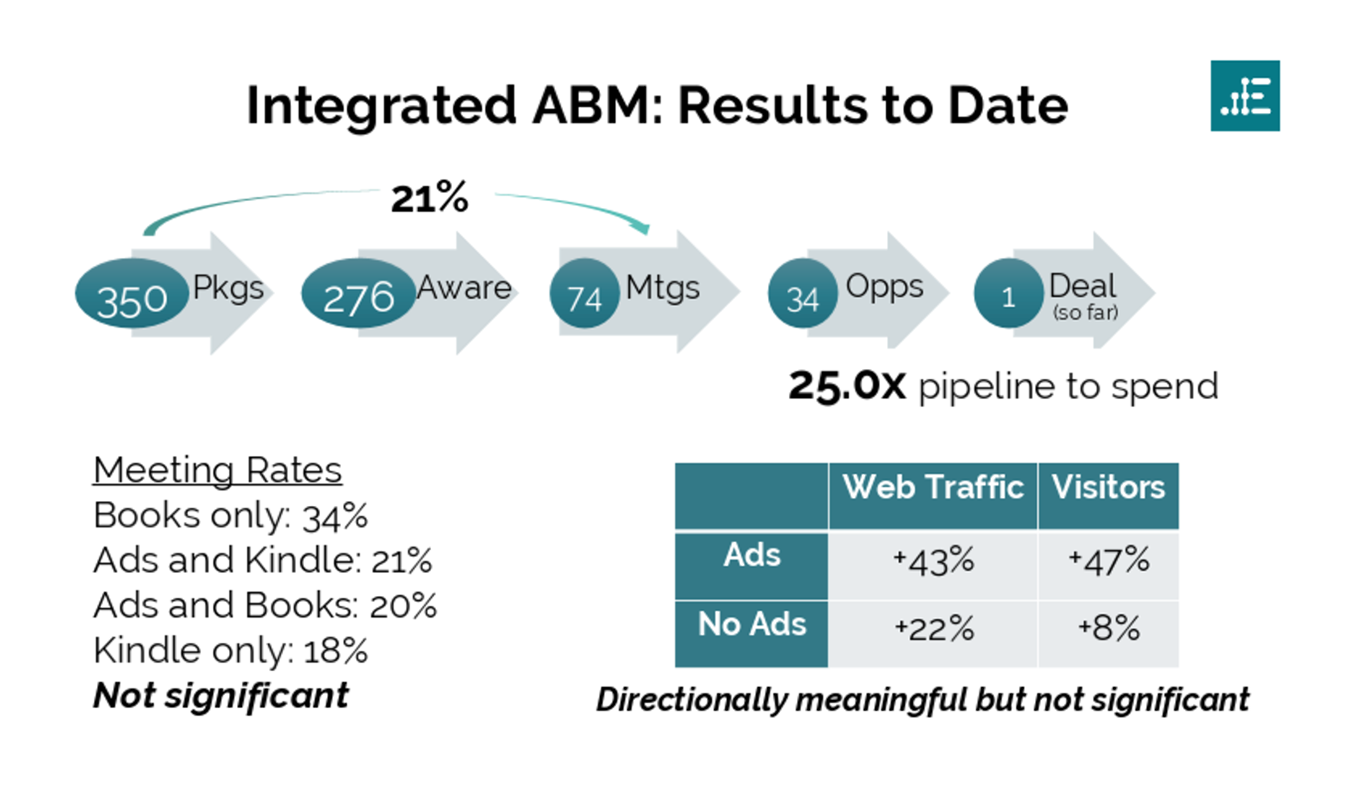
Conclusion
ABM without quality data isn’t worth your time, and bad data can sabotage even the best efforts.
There are three core pieces that B2B marketers need to make it work: great account data, great contact data, and a rigorous measurement and reporting system. Make sure these items are in place before you try it.
And if you’re still in doubt, pull a Mitchell: get a small budget, test it for a quarter, and prove you deserve more.
